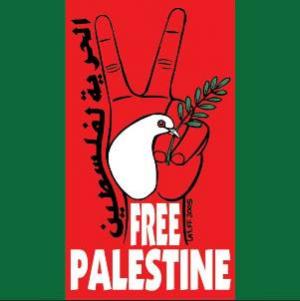World for Palestine 2010 Calendar

The World for Palestine 2010 Wall Calendar features twelve cartoons drawn by Brazilian cartoonist Carlos Latuff. Latuff’s images are stark, simple, and unflinching in their support of Palestinian resistance to Israeli occupation. His images, like most political art or propaganda, do not explore political complexities or nuances, but rather bluntly convey the truth through art. His images emphasize themes of global silence around the genocide of Palestinian people, the struggle of resistance by Palestinians against Israeli violence, and the emotional foundation of hatred that enables the destruction of Palestinian people and their homeland to continue.
This calendar will only satisfy those that are looking for blatantly politicized images. The use of cartoons for political purposes in the U.S. is most commonly associated with revealing the hypocrisy of elected politicians in daily newspapers. These cartoons were, at first, surprising to view because their intention was more simplistically and fiercely stated than I was used to. The artwork in the calendar is meant to nourish the spirits of those fighting the Israeli occupation and to uncover the brutality of the Israeli state.
As an example, one month of the calendar features an older Palestinian man’s hands and head sticking out of a set of gallows. The gallows are made out of a full Israeli flag, and the man’s face conveys pain and humiliation. The calendar succeeds in presenting such unwavering political metaphors, and the write-up in the beginning of the calendar that describes the Brazilian cartoonist, his intentions, and the context of his art helps to promote a better understanding the goals of the calendar and its art.
It is interesting to imagine other ways this calendar could have been presented. Latuff has a particular style, and the calendar may have benefited from a variety of artists. This would have shown the common elements of cartoons used to bolster Palestinian resistance, rather than focus on one artist’s work, which reinforces a similar aesthetic and specific political priorities. After a whole year of looking at these cartoons, it is easy to imagine how the complicated and profound human aspects of the struggle could be lost amidst the constant righteous outrage elicited by the images of one artist. More artists would have strengthened the depth of the viewers’ understanding.
This calendar certainly isn’t for everyone, and definitely not for fence-sitters regarding Palestinian peoples’ liberation. The World for Palestine 2010 Wall Calendar is strong and powerful in its convictions; hopefully Resistance Art will produce more calendars in the future that follow in this tradition.